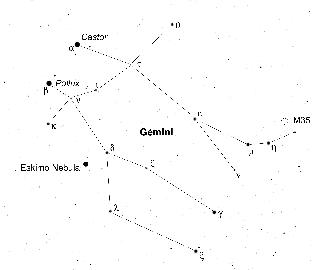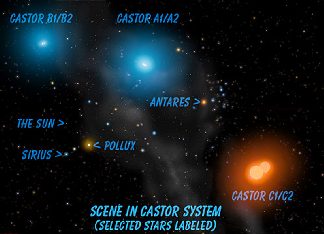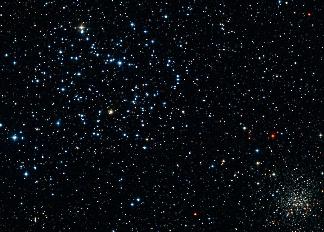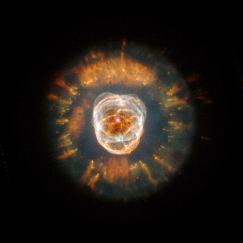Gemini
Castor - Multiple Star System
M35 - Open Cluster
Eskimo Nebula - Planetary Nebula
Gemini, best seen in the months around Christmas, lies north and east of Orion extending into the Milky Way. The heads of these two heavenly twins are delineated by the bright stars Castor and Pollux. Castor, though the fainter of the two, was given the Alpha designation by Beyer. It is a very interesting multiple star and A-List object. Gemini also contains an excellent open cluster close to the plane of our galaxy and a planetary nebula well worth seeking out.
Castor, Alpha Geminorum Multiple Star System Star E H
This is a visual double star made up of two blue-white stars, A and B, of 1.9 and 2.9 magnitudes respectively. The pair orbit each other every 400 years and are now as close as they ever get, making them somewhat of a challenge to split and requiring good seeing. In fact their spectra show that each is itself a double star! Castor A is made up of two identical 2 solar mass stars orbiting each other every 9.2 days while the stars that make up Castor B orbit even faster, every 2.9 days. One minute of arc to the south will be seen a faint ninth magnitude star. This is also part of the Castor system and is itself a double star consisting of two M-type dwarf stars about 0.6 solar masses. Amazingly, they are only twice the diameter of our sun apart and orbit each other every 2 hours. So Castor is actually a sextuple star system that would look absolutely amazing should one be able to pass close enough on a space journey!
Position 7h 34.6m +31deg 53min
M35 Open Star Cluster E B L
Just above the left foot of the northern-most twin the unaided eye can see a hazy patch of light whose size is somewhat more than that of the full moon. Binoculars will resolve this into individual stars spread uniformly within the cluster. The brightest are 8th to 9th magnitude. It is probably best seen in a telescope at low power using a wide-field eyepiece. M35 is thought to contain about 500 stars within a volume about 24 light years across and lies at a distance of 2700 light years. Given a very dark site and good sky transparency you may also observe a small compact cluster, just 5 arc minutes across, that lies half a degree southwest of M35. This is NGC2158, a cluster which, overall, has a visual magnitude of about 8 to 9. It is actually very similar is size to M35 but some 6 times more distant so appearing both smaller and fainter.
Position: 6h 09m +24deg 20min
Eskimo nebula Planetary Nebula H
This is a beautiful planetary nebula that has an unusually bright 10th magnitude central star which is a white dwarf. A central bright region forms the face with the white dwarf as its nose whilst a larger, more diffuse, outer ring makes up the fur hood of the Eskimo's parka or the ruff of the clown's outfit. Sadly this outer ring will not be visible except under very dark skies with a 4 inch (100 mm) telescope, but you will easily see the central region and white dwarf. An 8 inch (200 mm) will give you a reasonable chance of detecting the outer envelope even in less good conditions. It lies quite (2 degree 21 minutes) close to the 3.5 magnitude star Delta Geminorum. To the south and east of ? Geminorum lie three fifth magnitude stars: 56,61 and the double star, 63 Geminorum forming a right angled triangle. The Eskimo nebula lies just 37 minutes of arc to the south and a little east of the left hand star of the double. With a low power eyepiece it will be appear as a “stars” just to the south of an 8th magnitude star just 1.6 arc minutes away - the pair forming an apparent double. Increasing the magnification will reveal the true nature of the nebula as a 10th magnitude central star surrounded by a bright region of nebulosity. Its visual magnitude is about 9th magnitude. Incidentally, ? Geminorum lies just 10 arc minutes from the plane of the ecliptic and it was very close to both this star and the Eskimo Nebula that Clyde Tombaugh discovered the planet Pluto in 1930. As these notes were being written the point was reinforced as Saturn passed just 4 arc minutes away from the star!
Position: 7h 29.2m +20deg 55min







